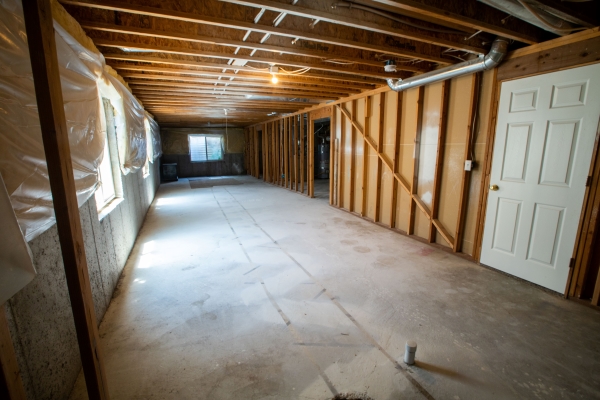Basements are one of the coldest spaces in a home. But while this quality makes a perfect space to retreat to during the hot summer days, it can be noticeably colder (or even unbearable) than other spaces during the winter.
While homeowners may simply endure the cold and shiver through the chill when doing laundry, it makes sense to heat the finished basement to improve the overall comfort of the home. Those who’ve experienced the extreme cold of basements or tried to heat the space before likely can’t help but wonder: which is the best way to heat a basement?
Let’s explore how to heat a basement.
6 Best Ways to Heat a Basement
Best Way: Insulate or Extend Your HVAC System
Broken and cracked HVAC ducts can be the culprit of lost energy in the basement. Repairing and insulating these HVAC ducts can enhance efficiency. If optimal temperatures are already achieved, it’s best to maintain it longer in the duct areas. To do so, consider adding insulation around the ductwork. This will save you energy, both in cold and warm climates.
If this existing HVAC system isn’t enough to heat a basement space and the cellar, consider modifying it using additional vents. Various factors come to play here to determine whether the existing system supports the extra load. Age and size are the main determinants.
Have an HVAC professional determine if extending the existing HVAC system is a viable option. If the unit is old, it may be impossible to push its limits, while if it’s too small, it might already be operating at full capacity. In such a case, the options are either to upgrade the system or install a new one.
Install an Electric Fireplace
Fireplaces are one of the best ways to keep the cold at bay in the winter. The ease of use of an electric fireplace makes it one of the most preferred home additions in cold regions. With a touchscreen and remote, the fireplace can provide heating to a room of up to 400 square feet. It’s only five inches deep, a quality which makes it possible to mount on walls. If appearance is a vital consideration, an electric fireplace achieves a timeless appeal.
Further, the fireplace heating method is environmentally friendly in that it uses renewable, clean, and slow-burning pellets. However, the process of heating leaves ashes, which some people consider inconvenient. This type of heating also produces carbon dioxide and requires a chimney to eliminate. The ease of installation and numerous options make this basement method ideal for most homeowners. It’ll work well for small, open-concept basements and may need to be accompanied by other heating methods for large basements.
Use Radiant Heaters
Radiant heaters are an excellent method for heating a basement. Many homeowners can attest to the success these heaters can have.
Consider installing electric heaters where the electric wiring is installed beneath the floors to radiate low-level heat to the floor. The heat will then rise to fill the entire basement.
Alternately, go for hydronic heaters where hot water circulated in pipes is placed beneath the floor to heat the surface. One advantage of this method is that the heat circulates throughout the entire space. The heat is also maintained for a long time.
Consider an Electric Space Heater
A space heater in the basement helps prevent the buildup of moisture. Since cold air holds less moisture, it tends to condense on walls and floors. Controlling this humidity in the basement helps prevent unwanted mold.
Electric space heaters come in handy as they are inexpensive (most cost under $100), they need no electrical circuit configuration and will plug directly into any ordinary power outlet.
There are three main space heaters, each with its pros and cons. While fan-driven space heaters are the least expensive, they are also the least efficient.
Micathermic heaters produce conventional and radiant heat, which quickly warm up the room. They are large and take up more space but can be mounted on walls.
The downside with electric space heaters is that the narrow stream of hot air they produce may not feel as comfortable as other basement heating methods.
Baseboard Heaters
There are two different types of baseboard heaters: convection and hydronic. Both are similar in that they provide slow, gentle heat through a room. They both have long metal frameworks that are built along the baseboard of walls. One advantage of electric baseboards is that they’re placed in specific areas. Plus, they’re perfect for a basement since aesthetics aren’t much of consideration.
To install them in a basement, a heating professional is needed to first determine the amount of heat needed for the room. After this, the expert will hard-wire the heaters into supply circuits.
Baseboard heaters require more than plugging into an electrical circuit; they need more power that can’t be drawn from an ordinary outlet. With baseboard heaters, you can heat specific areas of your basement. They also offer flexibility as they can be controlled individually with separate thermostats. The main disadvantage is that they use a lot of energy and take up a significant amount of your wall space.
Insulate The Basement Walls and Floors
Once you have your heating solution in place, insulating the walls and floors may be all it takes to balance the heat in the basement area. The basement may still be colder than the rest of the house, even with heating. When that is the case, heat loss occurs through the floor of the home. Adding insulation will keep the cold air out of the space and prevent the warm air from escaping.
Insulating the basement walls will make them more energy efficient. For the finished floors, consider subfloor panels to prevent moisture leaks. A professional HVAC specialist will help you choose the appropriate insulation method for your space.

